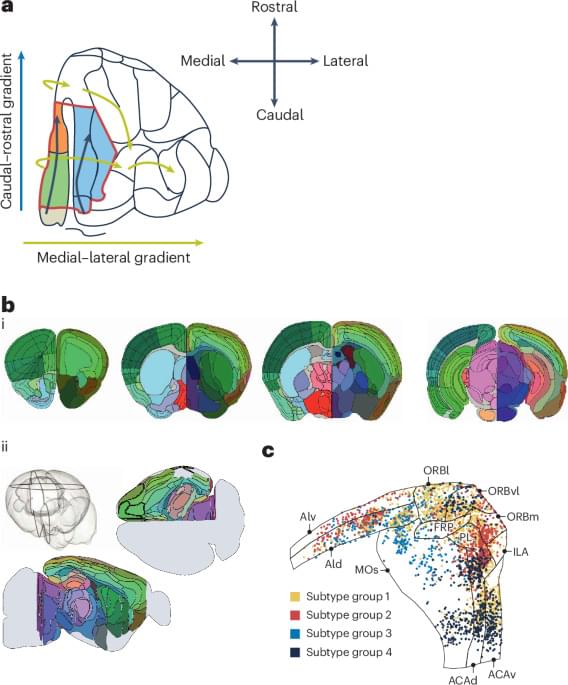Weizmann Institute has made revolutionary discoveries in cancer research, technology, education, environment, health & medicine and exploring the physical world.



For decades, neuroscience textbooks have taught us that the brain is organized into discrete areas — like Broca’s area for language or V1 for early vision, each with a well-defined role. This kind of areal parcellation has shaped how we interpret brain imaging, neural recordings, and even theories of cognition.
But this new article challenges that foundational idea. Instead of treating brain areas as the central units of brain function, the authors argue that brain organization is more complex, multi-layered, and distributed than traditional area-based frameworks suggest.
The authors begin with a simple observation: the ways in which neuroscientists define cortical areas, based on cell structure (cytoarchitecture), connectivity, or response properties — don’t always point to the same boundaries. In other words, different methods of dividing the cortex produce different “maps,” and there’s surprisingly little convergence on a single, definitive set of brain areas.
This inconsistency raises a big question: If areas aren’t consistently defined by structure or connectivity, can we really treat them as the fundamental units of brain function.
Parcellation of the cortex into functionally modular brain areas is foundational to neuroscience. Here, Hayden, Heilbronner and Yoo question the central status of brain areas in neuroscience from the perspectives of neuroanatomy and electrophysiology and propose an alternative approach.
Restoring Sight For Those In Need — Dr. Edward J. Holland, M.D. & Robert Dempsey — Co-Founders — Holland Foundation For Sight Restoration
Dr. Edward Holland is a world-renowned leader in corneal transplantation and severe ocular surface disease, and is the Co-Founder of the Holland Foundation for Sight Restoration (HFSR — https://www.hollandfoundationforsight… is a 501©(3) nonprofit organization, dedicated to transforming the lives of individuals affected by these conditions, including limbal stem cell deficiency (LSCD) – a rare and devastating condition that can result in chronic pain, profound vision loss, and blindness.
Through this HFSR initiative, Centers of Excellence (COEs) focused on the advanced sight restoration procedures of Ocular Surface Stem Cell Transplantation (OSST) are being launched across the country. As part of its mission, the foundation is also committed to broadening education and training so that more physicians nationwide can learn and implement The Cincinnati ProtocolTM for the management of these patients.
Dr. Holland is also the Director of Cornea Services at Cincinnati Eye Institute (https://www.cincinnatieye.com/doctors…) and Professor of Ophthalmology at the University of Cincinnati (https://med.uc.edu/landing-pages/prof…).
Dr. Holland attended the Loyola-Stritch School of Medicine in Chicago and trained in Ophthalmology at the University of Minnesota. He completed a fellowship in cornea and external disease at the University of Iowa and then completed a second fellowship in ocular immunology at the National Eye Institute, National Institutes of Health in Bethesda, Maryland.


This isn’t a high-security government facility. It’s Beverly Hills High School.
District superintendent Alex Cherniss says the striking array of surveillance tools is a necessity, and one that ensures the safety of his students. “We are in the hub of an urban setting of Los Angeles, in one of the most recognizable cities on the planet. So we are always a target and that means our kids are a target and our staff are a target,” he said. In the 2024–2025 fiscal year, the district spent $4.8 million on security, including staff. The surveillance system spots multiple threats per day, the district said.
Beverly Hills’ apparatus might seem extreme, but it’s not an outlier. Across the U.S., schools are rolling out similar surveillance systems they hope will keep them free of the horrific and unceasing tide of mass shootings. There have been 49 deaths from gunfire on school property this year. In 2024, there were 59, and in 2023 there were 45, per Everytown for Gun Safety. Between 2000 and 2,022,131 people were killed and 197 wounded at schools in the U.S., most of them children. Given those appalling metrics, allocating a portion of your budget to state of the art AI-powered safety and surveillance tools is a relatively easy decision.
Lex Fridman Podcast full episode: https://www.youtube.com/watch?v=_bBRVNkAfkQ
Thank you for listening ❤ Check out our sponsors: https://lexfridman.com/sponsors/cv9505-sb.
See below for guest bio, links, and to give feedback, submit questions, contact Lex, etc.
*GUEST BIO:*
Irving Finkel is a scholar of ancient languages and a longtime curator at the British Museum, renowned for his expertise in Mesopotamian history and cuneiform writing. He specializes in reading and interpreting cuneiform inscriptions, including tablets from Sumerian, Akkadian, Babylonian, and Assyrian contexts. He became widely known for studying a tablet with a Mesopotamian flood story that predates the biblical Noah narrative, which he presented in his book “The Ark Before Noah” and in a documentary that involved building a circular ark based on the tablet’s technical instructions.
*CONTACT LEX:*
*Feedback* — give feedback to Lex: https://lexfridman.com/survey.
*AMA* — submit questions, videos or call-in: https://lexfridman.com/ama.
*Hiring* — join our team: https://lexfridman.com/hiring.
*Other* — other ways to get in touch: https://lexfridman.com/contact.
*EPISODE LINKS:*
Irving’s Instagram: https://www.instagram.com/drirvingfinkel/
The Ark Before Noah (book): https://amzn.to/4j2U0DW
Irving Lectures Playlist: https://www.youtube.com/playlist?list=PLYXwZvOwHjVcFUi9iEqirkXRaCUJdXGha.
British Museum Video Playlist: https://www.youtube.com/playlist?list=PL0LQM0SAx603A6p5EJ9DVcESqQReT7QyK
British Museum Website: https://www.britishmuseum.org/
The Great Diary Project: https://thegreatdiaryproject.co.uk/
*SPONSORS:*
To support this podcast, check out our sponsors & get discounts:
*Shopify:* Sell stuff online.
Go to https://lexfridman.com/s/shopify-cv9505-sb.
*Miro:* Online collaborative whiteboard platform.
Go to https://lexfridman.com/s/miro-cv9505-sb.
*Chevron:* Reliable energy for data centers.
Go to https://lexfridman.com/s/chevron-cv9505-sb.
*LMNT:* Zero-sugar electrolyte drink mix.
Go to https://lexfridman.com/s/lmnt-cv9505-sb.
*AG1:* All-in-one daily nutrition drink.
Go to https://lexfridman.com/s/ag1-cv9505-sb.
*PODCAST LINKS:*
Australians in their 30s and 40s are facing an alarming surge in cancer diagnoses and researchers are scrambling to understand why.
From bowel and breast to liver and kidney, aggressive cancers are hitting younger people; they’re often detected late, with devastating outcomes.
Dr Norman Swan investigates what’s behind the change.
Could it be ultra-processed foods, stress, or exposures dating back to childhood, even pregnancy?
He meets those grappling with a diagnosis and searching for answers.
Generation Cancer asks what can be done to curb the rise, and are we ready?

The Letters section represents an opportunity for ongoing author debate and post-publication peer review. View our submission guidelines for Letters to the Editor before submitting your comment.

A suspected Russia-aligned group has been attributed to a phishing campaign that employs device code authentication workflows to steal victims’ Microsoft 365 credentials and conduct account takeover attacks.
The activity, ongoing since September 2025, is being tracked by Proofpoint under the moniker UNK_AcademicFlare.
The attacks involve using compromised email addresses belonging to government and military organizations to strike entities within government, think tanks, higher education, and transportation sectors in the U.S. and Europe.

New research published in Neuropsychologia provides evidence that adults with dyslexia process visual information differently than typical readers, even when viewing non-text objects. The findings suggest that the neural mechanisms responsible for distinguishing between specific items, such as individual faces or houses, are less active in the dyslexic brain. This implies that dyslexia may involve broader visual processing differences beyond the well-known difficulties with connecting sounds to language.
Dyslexia is a developmental condition characterized by significant challenges in learning to read and spell. These difficulties persist despite adequate intelligence, sensory abilities, and educational opportunities. The most prominent theory regarding the cause of dyslexia focuses on a phonological deficit. This theory posits that the primary struggle lies in processing the sounds of spoken language.
According to this view, the brain struggles to break words down into their component sounds. This makes mapping those sounds to written letters an arduous task. However, reading is also an intensely visual activity. The reader must rapidly identify complex, fine-grained visual patterns to distinguish one letter from another.